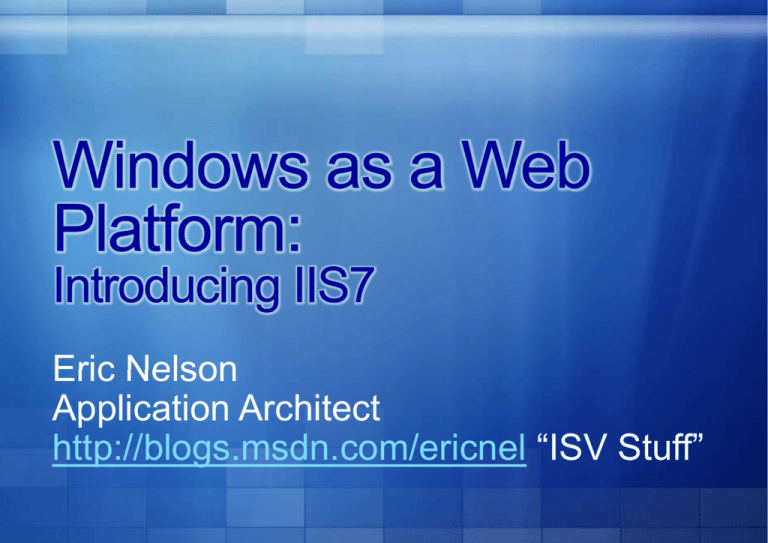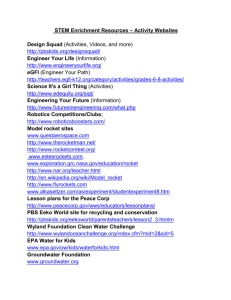
Windows as a Web
Platform:
Introducing IIS7
Eric Nelson
Application Architect
http://blogs.msdn.com/ericnel “ISV Stuff”
Two great things happened to Microsoft in
Feb 1996
1. Eric joined Microsoft
2.
IIS 1.0 was released and Microsoft “woke up” to the power of the Internet
Client/Server
“Smart Terminals”
GUIs for
Green Screens
Fat-Client + Database
LAN Communication
Microsoft
IIS 1.0, 2.0, 3.0
IIS 4.0 – March 2007,
then “downed tools”…
Web Client and Smart
Client
Internet, WAN and
LAN Communication
Microsoft
IIS5.0 (pretty much
IIS4.0)
Security Here goes...
SOA
Web 2.0
SaaS
S+S
ESB
ISB
Microsoft
IIS 6.0 in Windows
Server 2003
IIS 7.0 in Vista and
Windows Server 2008
Proven Scale
MySpace - 23 Billion Page Views/Month
Microsoft.com - 10k Req/sec & 300K
Connections
Match.com 30 million pages view daily
Proven Trust
54% of Fortune 1000 use IIS
(port80software.com)
Proven Security
No critical IIS 6 hotfixes since RTM*
Note to Qcon – could we have run this conference one month earlier?
A solid foundation to build on
IIS 7 was released in 2006 with Windows Vista
IIS 7 was released in Feb 2008 with Windows Server
2008
Microsoft.com
Switched to Beta 3 of Windows Server 2008 on June 12
2007
Great Compatibility
99%+ ASP and ASP.NET worked
One application encountered breaking change out of 260
And loved
AppCmd, new UI, death of metabase,
metabase shared config, failed
request tracing etc.
http://blogs.technet.com/mscom/archive/2007/09/07/the-tasty-morsels-found-in-dogfood-mscom-ops-tophttp://blogs.technet.com/mscom/archive/2007/09/07/the
10-changes-in-iis7-0.aspx
More than a Web server, Internet Information Services 7.0 provides an
accessible, extensible platform for developing and reliably hosting Web
applications and services
IIS 7.0 Enhancements
Modular Architecture
Extensible Design
Integrated with .NET
Manageable
Built in
Request Tracing
Create
Streamlined
Servers
Reduced
Attack Surface
Rapid
Application
Deployment
Extend/Modify
IIS Features
Fast
Diagnostics
IIS 7.0 Enhancements
Modular Architecture
Extensible Design
Integrated with .NET
Manageable
Built in
Request Tracing
IIS 6
IIS 7
Benefits
Architecture
Monolithic
Modular
Customize,
Extend,
Streamline
Setup
Most Features
Minimal
installed
installation for
(many disabled) designated role
Increased
Security
Extend
Features
ISAPI filters and Add modules
ISAPI
and handlers in
native or
extensions
managed code
Easier to
develop
application and
administration
features
Customize UI
Possible, but
not common.
Much easier for
developers to
provide new
admin features
Extensible,
modular, based
on .NET
Authentication
NTLM
Basic
Anon
…
CGI
Determine
Handler
Static
File
Monolithic implementation
Install all or nothing…
nothing…
Extend server functionality
only through ISAPI
ISAPI…
…
ASP.NET
ISAPI
PHP
…
Send Response
Log
Compress
Authentication
NTLM
Basic
Server functionality is split
into ~ 40 modules
modules...
...
Anon
Authorization
…
ResolveCacheCGI
…
Determine
Static
File
Handler
ExecuteHandler
ISAPI
…
…
UpdateCache
Send Response
SendResponse
Log
Compress
Modules plug into a
generic request pipeline…
Modules extend server
functionality through a
public module API.
Completely redesigned IIS Manager
Task-oriented
Allows IIS & and ASP.NET configuration
Extensible
Add management features
Add application configuration
View health and diagnostics within the UI
Remote administration over https
Manage 1 or 1000’s of sites
IIS 7.0 Enhancements
Modular Architecture
Extensible Design
Integrated with .NET
Manageable
Built in
Request Tracing
Authentication
NTLM
Basic
Anon
…
Determine
Handler
CGI
aspnet_isapi.dll
Static
File
Authentication
ISAPI
Windows
…
ASPX
…
Send Response
Log
Forms
Compress
Map
Handler
Trace
…
…
Basic
Anon
Authentication
Authorization
ResolveCache
…
ExecuteHandler
…
Classic (IIS 6)
Integrated Mode
.NET modules / handlers
aspnet_isapi.dll
Static
File
plug directly into pipeline
Authentication
Forms
ISAPI
Process
Windows all requests
…
Full runtime fidelity
ASPX
UpdateCache
SendResponse
Two App Pool Modes
Map
Handler
Compress
Log
Trace
…
…
IIS Manager, Modules, .NET
Integration
IIS 7.0 Enhancements
Modular Architecture
Extensible Design
Integrated with .NET
Manageable
Built in
Request Tracing
Metabase to Applicationhost.config file
Easier to use
Human readable XML
Config can be copied to other servers
You now have choices about how to
manage IIS configuration
Centralized Configuration
Delegated Administration
Shared Configuration
Contoso.com
\ Orders
.NET Framework
Machine.config
NET global settings
Site Root
Web.config
Global web.config
ASP.net
global settings
<system.web>
.NET settings
..
..
IIS 7
Applicationhost.config
Global settings and
location tags
..
<system.webServer>
IIS7 Delegated settings
..
Remote Administration
Use IIS Manager from XP, Vista, Windows Server
2003/2008
Auto-deployment
deployment and hide
Delegated Administration
Delegate control to site owners without elevated
priviledges
Extremely granular: Require Windows Authentication - let
site owner control turn on/off Basic
Shared Configuration
All administration tools are redirected to a common UNC
path
AppCmd
simple
cmd-line
syntax
powerful
mgmt
objects
inline help
& multiple
outputs
C:
C:\
\> appcmd list sites
SITE "Default Web Site" (id:1,bindings:HTTP/*:80:,state:Started)
SITE "Site1" (id:2,bindings:http/*:81:,state:Started)
SITE "Site2" (id:3,bindings:http/*:82:,state:Stopped)
(id:3,bindings:http/*:82:,state:Stopped)
C:\>
appcmd list requests
REQUEST "fb0000008000000e" (url:GET
/wait.aspx?time=10000,time:4276
wait.aspx?time=10000,time:4276 msec,client:localhost
msec,client:localhost)
)
C:
C:\
\> appcmd list requests /apppool.name:DefaultAppPool
C:
C:\
\> appcmd list requests /wp.name:3567
C:
C:\
\> appcmd list requests /site.id:1
Filter results by
application pool,
worker process, or
site
IIS 7.0 Enhancements
Modular Architecture
Extensible Design
Integrated with .NET
Manageable
Built in
Request Tracing
View Detailed Errors in the Browser
Access Runtime State Info in Real-Time
Real
Ex. See all currently executing requests
Rapidly Troubleshoot Faulty Applications
Rules define ‘failures’ that triggers report of
pipeline events
Define by http result code and/or time taken
Config files, Delegation, AppCmd,
Request Tracing
Most extensible yet
Modular, IIS Manager, .NET
Most .NET friendly yet
Integrated pipeline, shared web.config
Most manageable yet
Simplified deployment, server farms, administration
Xcopy of config files, shared config,
config appcmd
Easier to troubleshoot
Most secure yet
Reduced attack surface, .NET Integration for Auth, Application Pool
Isolation
URLAuthorization and Request Filtering
Most PHP Friendly yet…
PHP
MySQL
Apache
Linux
4
OR?
1
On October 30th, 2006, Microsoft and Zend announced a multi-year
multi
collaboration to improve the performance and stability of PHP on
Windows
Benefits
-Huge
Huge ecosystem of apps potentially being available on Windows
-Making
Making it easier for PHP developers to take advantage of the Microsoft
Web platform
CGI
ISAPI
Invokes a process for
each request.
Loaded as extension in
process.
Advantages
Easy to Configure
Stable Execution
Advantages
Better Performance
Disadvantages
Slow due to I/O
Overhead of
Disadvantages
Many PHP
Applications are
FastCGI
Extension to CGI allowing
reuse of a process.
Advantages
Easy to Configure
Faster than CGI
More stable than
PHP on ISAPI
FastCGI in IIS6
FastCGI in IIS7
Available from the Download
Center
Available in Windows Server 2008
and Vista SP1
Delivered as a separate download
from Windows Server 2003.
Delivered as part of IIS7. Users
must install the CGI feature in IIS
to enable FastCGI.
ISAPI extension
Native IIS7 module
Resources, forums, and reference
material available on IIS.NET
Product help documentation, as
well as resources on IIS.NET.
Configured via fcgiext.ini
Configured via the new XMLbased configuration system in IIS7.
Fully supported
upported by Microsoft
Supports PHP and other FastCGI frameworks
2
New Server Core installation option of Windows Server 2008 allows
for installation of server roles with only the necessary components
and subsystems
Benefits
-A minimal footprint, low-maintenance
maintenance web server that can host PHP
applications
-Providing
Providing an option that will resonate with PHP hosters and developers
http://www.microsoft.com/windowsserver2008/servercore.mspx
3
On October 9th, 2007, the first CTP of the SQL Server Driver for PHP was
released. Enables reliable, scalable integration with SQL Server for PHP
applications deployed on the Windows platform.
Benefits
-One
One answer to the question “What do we do with MySQL when we
become really successful?”
-SQL Server 2005 and 2008 rocks
-SQL
SQL Server 2005 Express is free option
http://www.microsoft.com/sql/technologies/php/default.mspx
4
The next version of Expression Web will be the first
Microsoft tool to offer PHP support.
Benefits
- An alternative great tool for Designers using PHP
http://IIS.NET
Walkthroughs, examples, and code samples, online labs
Webcasts
http://www.microsoft.com/emea/spotlight/result_search.aspx?produ
ct=12 (August 24th)
http://iis.net/PHP
Specific applications
http://learn.iis.net/page.aspx/271/php
http://learn.iis.net/page.aspx/271/php-applications-on-iis/
© 2007 Microsoft Corporation. All rights reserved. Microsoft, Windows, Windows Vista and other product names are or may be registered trademarks
trademar and/or trademarks in the U.S. and/or other countries.
The information herein is for informational purposes only and represents the current view of Microsoft Corporation as of the date of this presentation. Because Microsoft must respond to changing market conditions, it
should not be interpreted to be a commitment on the part of Microsoft, and Microsoft cannot guarantee the accuracy of any information
inf
provided after the date of this presentation.
MICROSOFT MAKES NO WARRANTIES, EXPRESS, IMPLIED OR STATUTORY, AS TO THE INFORMATION IN THIS PRESENTATION.
Want to ensure that a new process is created if no processes are
available to handle a request?
Run one instance per CPU with a minimum of 4 instances
Set maxInstances to the lowest possible number under full load
without consuming 100% CP
Want to make sure that the existing process is recycled
periodically?
Set instanceMaxRequests (number of requests to process before
recycling) as high as possible without destabilizing the app
PHP process’ maximum request setting (PHP_fcgi_max_requests) has
to be equal or higher than the instanceMaxRequests setting.
<fastCgi>
PHP\php-cgi.exe"
<application fullPath="C:\PHP
maxInstances="4"
instanceMaxRequests="10000"
idleTimeout="300"/>
Want to set PHP specific environment
variables in the web.config file?
Use environmentVariables configuration
setting to set PHP specific environment
variables.
<fastCgi>
<application fullPath="C:\PHP\php-cgi.exe"
fullPath="C:
instanceMaxRequests=“10000">
<environmentVariables>
<environmentVariable
name=”PHP_FCGI_MAX_REQUESTS”
value=”10000”/>
</environmentVariables>
</application>
</fastCgi>
Is your server under so much load that
your clients are getting timeout
responses?
The FastCGI process will be terminated if it
does not respond to FastCGI handler within
specified time period.
Set the requestTimeout (number of seconds
<fastCgi>
to
wait
for
process
to
handle
the
request)
<application fullPath="C:\PHP\php-cgi.exe"
fullPath="C:
value
to be higher than the activityTimeout
activityTimeout=“30"
requestTimeout=“90"/>
(number
of seconds to wait for any process
</fastCgi>
activity) value.
When did it start?
What is it?
PHP is a general-purpose
scripting language
PHP is primarily used as a
server-side scripting language to
create Web applications, but
can also be used for command
line scripting and for desktop
applications
PHP is Open Source and
cross-platform
PHP
PHP succeeds an older
product PHP/FI, which was
created by Rasmus Lerdorf in
1995
PHP
PHP 4.0 was first released in
May 2000 (currently the most
popular major release)
PHP
PHP 5.0 was released in July
2004 and the release of PHP
6.0 alpha is anticipated early in
2008
Why is it used?
Easy to pick-up and
understand, especially without a
programming background
Low cost of entry, including
shared hosting that usually
includes database storage
Huge ecosystem, including
applications, tools &
documentation
An example of a simple PHP script which sends the text "Hello World" to the browser:
<html>
<head>
<title> PHP Hello World Example</title>
</head>
<body>
<?php
echo “Hello World!”;
?>
</body>
</html>





